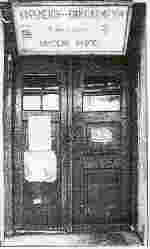Though dwindling in numbers, a few kafeneia still pepper the city's downtown and keep up residence in neighborhoods like Sepolia, Peristeri, Kolonos and Petralona, working-class and middle-class places, where the old style coffee shops seem almost anarchronistic now, hidden behind the grimed windows of time.
Inside a kafeneion there is a simple bar, and plenty of marbletop tables and straw chairs where men, many dressed immaculately in sport coats with buttoned cardigan sweaters and ties, can debate politics and philosophise over life usually through fogs of smoke. Many of these men have been going to the same kafeneion for decades.
At kafeneion Hara on Agias Sophias Street in Sepolia, owner Nikos Alatzides, while serving a group of men clustered around cards at one table, says he wonders sometimes what will happen to such traditional gathering places.
"Most of them are old and there is no other place to go...Fewer people come year after year," he says. The economic downturn has hit the clientele hard, he adds. "People don't come as often, and they try to spend as little as they can."
But true to its name, there is much hara (joy) in this establishment, as the men commiserate and laugh loudly, some playing komboloi (worry beads) through their fingers, others sitting alone in silent contemplation.
Yiannis Kalfaglou, a pensioner, who has been coming twice a day for 18 years, said the kafeneia have fiercely loyal customers, almost always older men who bond and form a club-like atmosphere. "They are all friends," he says, and continues, "There's nothing for a woman to do here." And while newcomers are eyed a bit warily, and Greek is by and large the exclusive language, buying a round of drinks opens the door to a rich experience that isn't found in the bustling establishments where people have no time to linger and think.
'Small Parliament' - Near the Acropolis metro station sits a kafeneion with no name on its window, just signs offering coffee, beer and ouzo. Yiorgos Pandenas has owned it for a year, although it's been there more than 20, and says he likes that it is old and traditional, although some women come in occasionally. "The coffeeshop is a small parliament," says patron Makis Lazaratos.
Lazaratos, 60, says he remembers when there were nearly 20 kafeneia in a small zone in the Plaka in the 1960s, now replaced by cafeterias, fast-food shops, or stores selling souvenirs, t-shirts, soap and all manner of bric-a-bric.
He says he has seen what the invasion of foreign companies and a more modern lifestyle has done to the kafeneia. "They are starting to vanish. Young people don't follow the rules here to play cards. We grew up this way."
One could say that the rules, in general, at a kafeneion are that life be sipped and savoured and not rushed, and where the flow of history be remembered and recounted daily.
The kafeneia have made small concessions to the changing times - a few video games and television sets for patrons to watch the news or sports.
At the kafeneion Phanellineion at the corner of Solonos and Mavromihali streets, chess has been the draw for some of the country's and world's best players, men like George Plastiras, 90, and Dimitris Volizakis, 83, who sat in a corner meditating over their next moves.
George Katsonis, who has owned the place since 1991, praises the kafeneion tradition: "The person who comes here has an hour to spend, to do something creative with his life. It's not a place where people are pushed out the door to make room for the next customer." Like many kafeneia, it is decorated with old photographs and rife with an atmosphere of the luxury of being languid.
Not far away, at Mouria. Yirgos Christopoulos, 42, presides over a kafeneion that goes back to the 1900s, lavishly filled with antiques, puppets, figures of the Revolution, paintings, gas lamps and a giant wall mirror.
"There is tradition and an older way of living," he says. He talks of how elderly men come in the afternoons and younger people and women later in the day, drawn from the nearby neighborhood of Exarcheia. "There's more communication here. You can't do that at a McDonald's."



